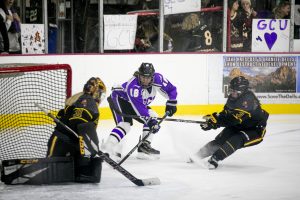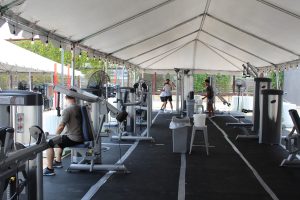- Slug: Club Sp0rts COVID, 1,109 words.
- 3 photos and captions below.
By Derek Moskal
Cronkite News
PHOENIX – Although Division I sports have found a route to safely hold seasons and tournaments, club sports are a different story, especially in Arizona.
The state’s four major universities have handled club sports in different ways during the COVID-19 pandemic. Grand Canyon and the University of Arizona have implemented systems and procedures that allow practices and even a handful of games. Northern Arizona and Arizona State, however, determined no club games or full practices would be allowed for the spring season.
Arizona allowed the most activity among the four schools. Officials say they have done all they can to encourage physical activity and make it accessible for the students. Since early summer, Troy Vaughn, the director of campus recreation, and his team have been slowly opening up various recreational facilities for students.
In June, they opened their outdoor pool, and in July, they constructed an outdoor weight area right outside the recreational complex. The weight area was covered with tents, and students were required to wear masks and be socially distant.
As the fall arrived, club teams were allowed to condition and lift together, Vaughn said.
“So men’s rugby and men’s lacrosse were the two who were really instrumental in starting that process and they worked really closely with that ICS staff and my staff,” he said.
The ICS, or Incident Command System, worked with Vaughn and his team of campus administrators, associate and assistant directors, athletic trainers and even medical professionals to stay informed on COVID-19 trends.
“So as that all went along, we had our peaks and valleys… but starting around the middle of January, we started to note that we were having some pretty significant declines,” Vaughn said.
These declines in positive cases led to teams, such as lacrosse, to compete against other teams.
The only requirement, he added, is that, “Opposing teams, whether we go there or they come to us, need to have an even stronger testing protocol than we do here.”
The men’s lacrosse team found at least two schools which met the Wildcats’ testing protocols. The first was Minnesota, and the second was Grand Canyon University.
In Phoenix, Grand Canyon also found a system to organize activities for club sports. Although they have fewer activities than the Wildcats, the club sports at GCU are allowed to practice and condition together. Daniel Nichols, director of club sports, worked with the athletic training and sports medicine staff, along with other administrators, to create what he believes is a safe environment for club sports.
“The expertise lies in the outstanding staff in sports medicine,” Nichols said. “They also work with healthcare professionals here that oversee the entire university on protocols, and then they also work with a specialist who is in charge of COVID protocols across the university. There’s a lot of cooperation and a whole lot that goes into it.”
However, Nichols noted that GCU is hosting around eight or 10 games between all the club sports, and they will not be traveling.
Arizona State declined an interview about club sports, but Julie Kipper, the Executive Director of Health, said in a statement, “To keep students healthy, we not only review the state data but also take into consideration what is happening on all ASU campuses.”
ASU made the decision to cancel club sports well before the spring semester even started. Chas Messman, a junior on the ASU men’s lacrosse team, was shocked at how early ASU made this decision.
“Moving into the end of the fall they notified us that we probably won’t be having a season in the spring which was a shock because it was like three or four months before our first game would be,” he said.
Northern Arizona University in Flagstaff operated under a strict set of safety protocols, including only meeting in groups of 10 or less.
“We feel that this approach best protects our athletes and Lumberjack community while still allowing teams to stay current with their conditioning and skill development,” Paul Rehn, the Assistant Director of Recreation, said in a statement.
The schools prioritized the safety of the club participants differently.
“Everyone wants the same thing here. Nobody wants to go into a situation where people are unhealthy, where we change the fact that we get positive cases,” Vaughn said. “My whole motto since the start of COVID has been the safety of everyone involved.”
Addressing the connection between staying active and mental health, especially during a pandemic, is important, he said.
“What we found very quickly in the fall when we started to condition together as sport clubs, that camaraderie, while distant, was still so refreshing to see teams together and be able to workout together and laugh and joke,” Vaughn said.
GCU also emphasized the positive impact that sports can have on the students and the campus as a whole.
“I have to give credit to the university for seeing the value that club sports provides. It provides a great level of activity for students to continue to play the sport they love and compete at a really high level,” Nichols said. “It provides a great recruitment tool, student retention goes up, the students love going to the hockey and rugby games. So there’s just so many benefits that the university recognizes, and they were certainly on top of all the safety protocols.”
Club sports at UA and GCU, said officials, have benefited from a surplus of communication. From athletic directors to health officials to the club teams themselves, providing information about the latest COVID-19 data has been a priority.
“I think that’s been the key and a lot of our successful comeback up to date so far is that we have communicated incredibly well, and our clubs have been very very patient,” Vaughn said.
Messman, the ASU lacrosse player, thought information distribution at his university was slow.
“As far as I know, there hasn’t been a lot of communication with our president and our coaches. So for a while, we were just waiting and waiting for any updates, but we heard nothing,” he said.
Kipper believes the varying approaches taken by the universities are “related to the varying administrative structures.”
For the athletes, this reasoning doesn’t make the situation any better.
“It just sucks because we see other schools like GCU and UA playing, so we know it’s possible for us to be at least practicing, but I guess the school just decided against it,” Messman said.
Vaughn believes it’s best not to compare the schools.
“Some universities,” he said, “just look at things differently, and it doesn’t make them any worse than what we are and it doesn’t make us any better.”
For more stories from Cronkite News, visit cronkitenews.azpbs.org.



[/caption]